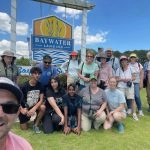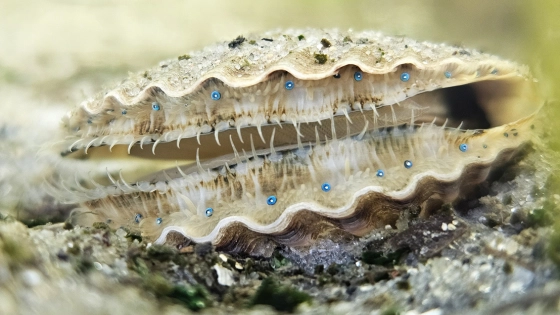 By Claire Rush Blades, Eco-Tourism & Aquaculture Sales Manager, Baywater Seafood
By Claire Rush Blades, Eco-Tourism & Aquaculture Sales Manager, Baywater Seafood
Baywater Seafood started as a little idea to grow a once forgotten bivalve in Maryland’s coastal bays, the Atlantic Bay Scallop. The stars aligned for founders Lee Beauchamp and Matt Holloway when a local marina came up for sale in 2020. Matt, one of the brothers behind Baywater Farms, branded the new venture with the Baywater name. After nearly a year of renovations to the property, Baywater Landing Marina became the home base for their aquaculture and mariculture operation.
Over the last five years, Baywater Landing and Baywater Seafood have expanded to be a shellfish nursery and hatchery, a mariculture oyster and scallop farm, a crabbing operation, an environmental education hub and an eco-tourism host at the marina.
Baywater Seafood raises its bay scallops and oysters throughout three lease sites in the Chincoteague Bay. They vary from 1 acre to 20 acres in size. Bay scallops need higher salinity but shallow depths to survive. The Chincoteague Bay is the perfect habitat for them because of the high influx of ocean water flowing through inlets, but the average depth is only about 5 feet. The scallops are grown in lantern nets. Think of an accordion-style net, hung vertically in the water column with seven levels for bay scallops to grow in. This allows them to be up and off the bottom, where they can filter feed an abundance of nutrients from the water column.
The “Baywater Brine” oysters are also in the perfect spot. Who doesn’t love a salty oyster? Because they are also filter feeders, they take in surrounding water to digest nutrients, meaning they take on the briny flavor of the Chincoteague Bay.
While aquaculture is the more common term used for growing shellfish and other aquatic species, mariculture is the better term for how Baywater Seafood grows. Mariculture is the raising of an animal in their natural environment with no manipulation or additives to its life. Because bay scallops and oysters are both bivalves, they are free to filter feed in the open bay without any interference. The only times that the staff interacts with them is to clean their nets/cages of biofouling (any living growth like seaweeds or barnacles that grow on and around the enclosures, or silt/mud accumulation), and to separate the individuals out as they get bigger so they have more space to continue growing. The more space they have between each other, the faster their growth rates become, allowing them to get to market faster.
This is especially important for the bay scallops, as their lifespan is only about two years. They must grow at about 50 individuals per layer of the lantern nets for optimal growth. Oysters live much longer, so there is not nearly as much of a time constraint on getting them to size. Bay scallops can grow from “seed” (or “spat,” which are baby shellfish) to a marketable size in about six months when the water is warm enough and they have enough nutrients, which comes down to adequate water flow and space to feed. Because they are grown in the water column in suspended lantern nets, they can take advantage of the bay’s current and influx of micro-organisms in the bay’s channel.
When the staff tend to the bay scallops and oysters, they begin at dawn. Especially in the hotter months, all work must be completed with oysters by, for example, 11:30 a.m. in June. It is even earlier in July and August. This is to ensure they do not get too hot internally, where they can develop a bacteria like Vibrio, which is dangerous for humans to consume. Bay scallops are not susceptible to the same infections as oysters, so the restrictions do not apply to them. This creates some flexibility in harvesting, but with the demand for getting orders fulfilled, they are harvested from their sites by early morning so the staff can get to work processing them as soon as possible.
Once they are brought in from the Chincoteague Bay, the bay scallops and oysters are hand-cleaned of biofouling and our bay scallops are finished in an industrial scrubber/tumbler. Bay scallops are tightly bagged, tagged and out the door. Usually, the same day. The staff “tightly” bags them because a bay scallop’s resting position can be ajar. Unlike an oyster or clam, this does not mean they are dead. They are a very active bivalve, opening wide to filter feed, but furthermore, they possess a defense mechanism: swimming! They use jet propulsion to shoot water through their bodies and out one side or the other of their shell near their hinge. This means they often attempt this defense mechanism outside the water, resulting in a “clapping” of their shell, or remaining ajar. And, because they can shoot water out of the back of their shells, they do not seal up watertight like oysters and clams. By tightly wrapping them in their bag, they are pinned shut, allowing more moisture to be retained and a longer shelf life in the fridge.
As the steps needed for the longevity of Maryland’s waterways and industries along the coasts are better understood, more folks are seeing the need for aquaculture and mariculture. More bivalves in our waters means more filtration, which means fewer toxins and higher oxygen levels in the water, resulting in better survivability of all aquatic species. In turn, this means higher biodiversity and increased aquatic vegetation, resulting in overall healthier water. Folks who support shellfish farmers are allowing wild populations of shellfish to thrive, have a hand in supporting local businesses, and are actively choosing protein sources that produce one of the lowest carbon emissions of any farmed animal.
Hungry for more? Read about a Maryland waterman. Learn more about blue crabs.
Sign up for our newsletter and find us on Facebook, Twitter and Instagram.

